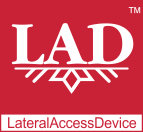
LateralAccessDevice
takes you back to before the Internet
How It Works | Download LAD | Support | LAD Security | Features & Uses | Resources | Members | User Guide
LAD for VoIP: VoIP TelephonyFirst a little bit of history — we can skip the string and two cans.... In the beginning a wire connected a telephone set to a switch, which in turn connected to other switches and telephone sets. The first calls were switched manually, and then later automatic switches replaced the telephone operator (to the chagrin of some, but relief of others). The principle, however, was the same: whatever audio the telephone set on one end captured was transmitted over the wires, through the switches, ultimately to reach the telephone set on the other end, which played the audio through a speaker. Automatic switching brought more affordable long distance rates, and, for the first time, introduced digitization, through which the voice was digitized and packaged into small packets of data representing short burst of audio (utilizing about 100 packets per second of audio). The switches transmitted these packets across digital long distance telephone networks, however, the local telephone connections largely remained the same, based on copper wiring, which is why the quality of the audio used to be so markedly different between high quality local and lower quality long distance calls. Perhaps, most notably, digitization introduced so-called latency (i.e., the delay between the time the speaker said something and the time the listener heard it) and sometimes echo, however, it increased versatility and brought down costs. Then along came the first experimentation with VoIP. Our people were there at the forefront in the late Nineties with the first working VoIP solution (before it was even called VoIP) and then later first working VoIP PBX, VoIP fax... and it grew from there. VoIP is essentially the same digitization process introduced much earlier for long distance calling, with the digitally packaged audio transmitted from caller to caller entirely over the Internet (or other digital network) and then re-assembled and played on the receiving end. Back then the traditional telcos insisted that there was a qualitative difference between their service and VoIP (while using the same digitization methods themselves). Now VoIP is universally embraced and is the primary mode of communication, especially for long distance, with a change in the number of packets, which varies from 100 per second down to 30, or sometimes even 20, packets per second. How does LAD fit into all of this history? LAD's SIP server gives you the unique ability to directly connect up to 1000 telephone sets and administer them as you see fit, with versatile call processing provided with its VoIP PBX features. And conduct up to 1000 telephone calls simultaneously. To put that in perspective, most businesses that had digital trunking (as it was called back in the day) were capable of having, at most, 24 telephone sets connected and 24 telephone calls happening at the same time. Practically speaking, for you it means that if you have more than 1000 friends you need two LADs. If less than 1000, you can have them all connected and talking in your own private telephone network. With the option to connect to various service providers... or not. It's up to you. |